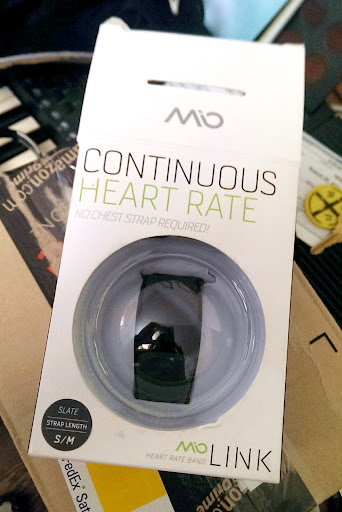 One way you can tell I am not a professional blogger is that I am posting this review now, rather than, say, a month before the holidays as a "Great Gift for the Runner In Your Life!"
One way you can tell I am not a professional blogger is that I am posting this review now, rather than, say, a month before the holidays as a "Great Gift for the Runner In Your Life!"
(Newsflash: You are the runner in your life. Does anybody actually go "WELL THANK GOD FOR THIS LIST, I HAD NO IDEA WHAT TO GET ALL THOSE RUNNER CLOSE FRIENDS/FAMILY MEMBERS THAT I TOTALLY NEED TO BUY GIFTS FOR"? I have serious doubts.)
I think it's a great product, though, so now that I've used it pretty consistently for several months, I figured I might as well share my thoughts.
As I've mentioned before, I gave up on wearing the chest strap with any regularity a couple of years ago because of the bloody, mutilated patch of skin it inevitably left on my chest. (I'm pretty sure I have permanent scars, actually.)

ca. 2011. Yes, it did actually get this bad.
I found heart rate-based training incredibly useful, though (you can read more about the hows and whys in this post), & tried going back to it with the Garmin soft strap early last summer. Alas, it turns out there is no strap in the world soft enough to make wearing the thing every day bearable. So after reading a few favorable reviews of the Mio, which uses a wrist strap instead, I decided to give it a shot.
The first thing to know is that Mio makes two different HR monitors -- the Link 56P-GRY, and the Alpha I. The link is just a strap with a sensor that connects via ANT+ to a device (GPS watch, phone, etc.), whereas the Alpha I is a self-contained monitor that displays your HR on a screen. I wanted mine to sync to my Garmin so I got the Link.


The monitor itself is a small, plastic pod with LED sensors on the underside.
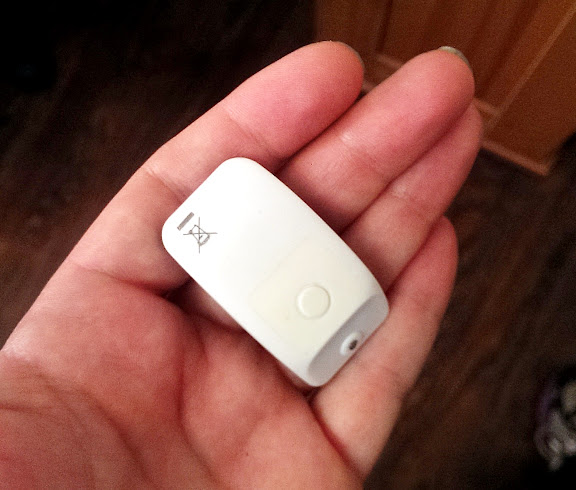
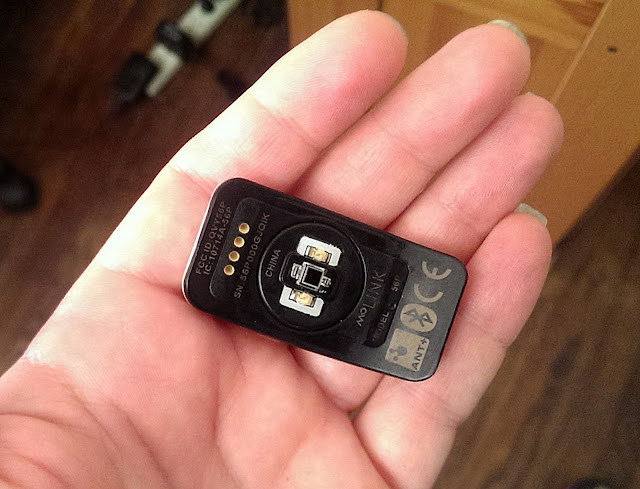
You slip the monitor into a pocket on the rubber strap, buckle it snugly around your wrist, turn it on, have your device scan for it, & boom, there's your heart rate.
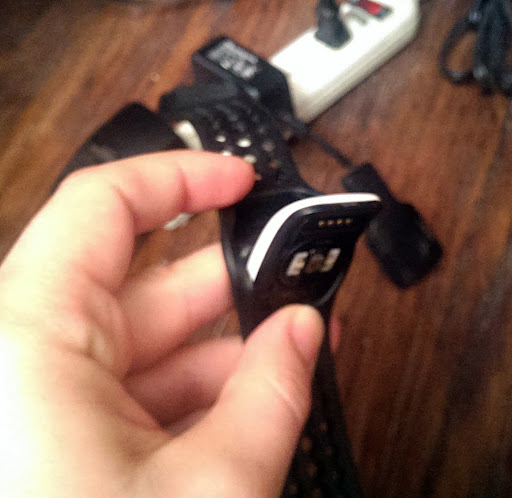

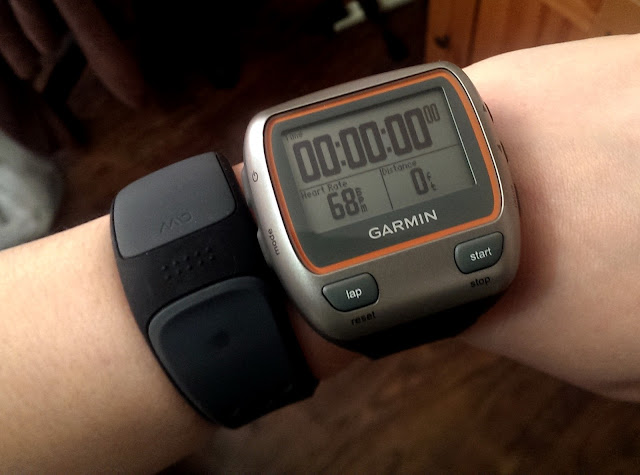
When you're done, just pop out the plastic pod & plop it on the charger.


(FYI, mine did not come with a plug adapter. The charger is USB, but for me it was simpler to just stick the USB into the adapter so I could plug it into a normal outlet.)
The only physical feature of note on the Link is the little LED light on the side that turns turquoise when it's charging & when you first turn it off. You can also program it to flash different colors for up to five different heart rate zones (green through red), but I've never bothered with this since seeing the number is good enough for me. (This means mine flashes all kinds of crazy colors all the time & I have no idea what any of it means & just ignore it.)
Over the last few months I've gotten a few questions about it from folks who are thinking about buying one (or just curious); my answers are more or less compiled below.
Q: How does it work?
A: The Mio is an optical heart rate monitor, meaning it uses LED light sensors, a fundamentally different technology than the electromagnetic sensors used in chest straps and hospital EKGs.

The LEDs are not actually that blinding; my shitty phone camera just didn't deal with them particularly well. Here is another focused on the LEDs, which is closer to what they actually look like:

According to this CNET article, "Unlike chest strap heart rate monitors -- which closely emulate a real EKG machine by measuring electrical pulse -- these devices use light to track your blood. By illuminating your capillaries with an LED, a sensor adjacent to the light measures the frequency at which your blood pumps past (aka your heart rate). Moments later, you've got a BPM (beats per minute) reading." This is why you need a tight seal against your skin for the Mio to work--any outside light will interfere with the LED sensors. It doesn't need to be boa constrictor tight, but it does need to be snug.
Q: Is it comfortable?
A: I don't even notice it when I'm running and kind of forget it's there, so yes. Like I said, in order to function properly the LED sensors do have to be right up against your skin so it does need to be buckled snugly, but it shouldn't be so tight it's uncomfortable. (See the pic above with my watch.)
Q: How accurate is it compared to a chest strap?
A: According to the Mio website, it reports "EKG-accurate heart rate data at performance speeds." The details of the technology were a little fuzzy to me, so I looked into it a little more. As the CNET article above explained, the technology is different from that used in chest straps, which, like an EKG, use electromagnetic sensors to actually pick up the electrical signal that tells your heart to beat, not the beat itself.
Because optical sensors pick up capillary blood volume (essentially measuring pulse), prior generation optical HR monitors have not been as reliable as chest straps or EKGs, and can become wildly inaccurate if the wearer is not completely still (making them rather impractical for athletes). The CNET article tested several wrist and fingertip monitors, including some specifically marketed for use during athletic activity, and indeed found some serious discrepancies (up to 10% in some cases), whereas the chest strap models tended to be dead-on & match a medical EKG machine exactly. (The fingertip monitors were pretty close as well, though.)
This, however, is where Mio comes in. The problem they've solved isn't optically measuring heart rate accurately; it's optimizing that technology to deal with the jostling and jarring of athletic activity. The technology itself apparently comes from Philips Medical & is exclusively licensed to Mio, so it would make sense that they'd have a significant advantage over other wrist straps in terms of accuracy on someone who is moving around a lot.
Of course the only way to empirically answer the question of whether the Mio is as accurate as a chest strap is to wear both at the same time & look at what the numbers do. And lucky you! DC Rainmaker did just that and found the two to be in near perfect agreement. Indeed, the numbers I've seen on mine are very much in line with what I used to see with the chest strap, even at faster paces (though I haven't done any speed work with it yet), and although I've read that a few people have occasionally experienced brief lags or drops in the signal, I haven't had any of those issues.
Q: Is it compatible with my [x device]?
A: As far as I can tell, it seems to be compatible with just about everything in existence--iThings of every ilk, Google Nexus 4/5, Android Jelly Bean or higher, & a whole slew of GPS watches & other training devices. I've only used mine with my Garmin FR 310XT, but it's been great. In four months I haven't noticed any lags, spikes, or drops of any kind.
Q: Battery life?
A: The site says it will last 8-10 hours on one charge. For the most part I tend to plop it back down in the charger after every run out of habit, just like my watch, but when we went to Spokane for Thanksgiving, I forgot to bring the charger & it lasted the whole week (~7 hours of use, maybe?) with no problem.
Q: Cost?
A: The Link retails for $99 right now, I think, though I got mine refurbished on Amazon for ~$75ish & have been completely happy with it. There are some pieces of running gear where I have to question whether it's worth the cost, but for me, being able to use a heart rate monitor every day in complete comfort has absolutely been worth it.
So really, it just kind of comes down to whether you want to train with a heart rate monitor and what it's worth to you. If the answer is yes and you've been thinking about it for a while and $80 or so is not going to break your budget (think of it as a race entry, more or less), I can't recommend the Mio Link more highly.
OK, so maybe they improved this, but the problem I had with the Mio Alpha that I was given, which was like the first version they made, was that it was a shitty watch. The HR worked fine, but it like couldn't do basic timing, lap intervals. You couldn't look at your HR and the watch. And, it would beep constantly if I was out of some zone that it had decided I should be in. Not very helpful.
ReplyDeleteI think that's something there's been a lot of confusion about. From everything I read, even the Alpha was never intended to be a watch -- it literally is a heart rate monitor and nothing else. So I think you'd probably only ever get an Alpha if you didn't care about anything else except heart rate & didn't care about the data being recorded anywhere. (Thankfully, the Link doesn't beep -- that would drive me insane.)
DeleteYour "gifts for runners" rant: spot on!
ReplyDeleteI used to wear the heart rate monitor strap that came with my Garmin but like you, it chafed the shit out of me to the point where I couldn't wear it anymore. I love having the extra data but am not interested enough in heart rate training (which I'm sure is great! I'm just lazy) to invest in an extra device. But if I ever decide to go that route, this seems like a cool option! I had NO IDEA you could measure heart rate with LEDs. Cool!
I hadn't seen this, very cool. I've tried a couple of HR-through-wrist watches and had issues with rashes from the metal on the wrist, I may do some research to see if anyone has issues with this one. Thanks for the review!
ReplyDelete